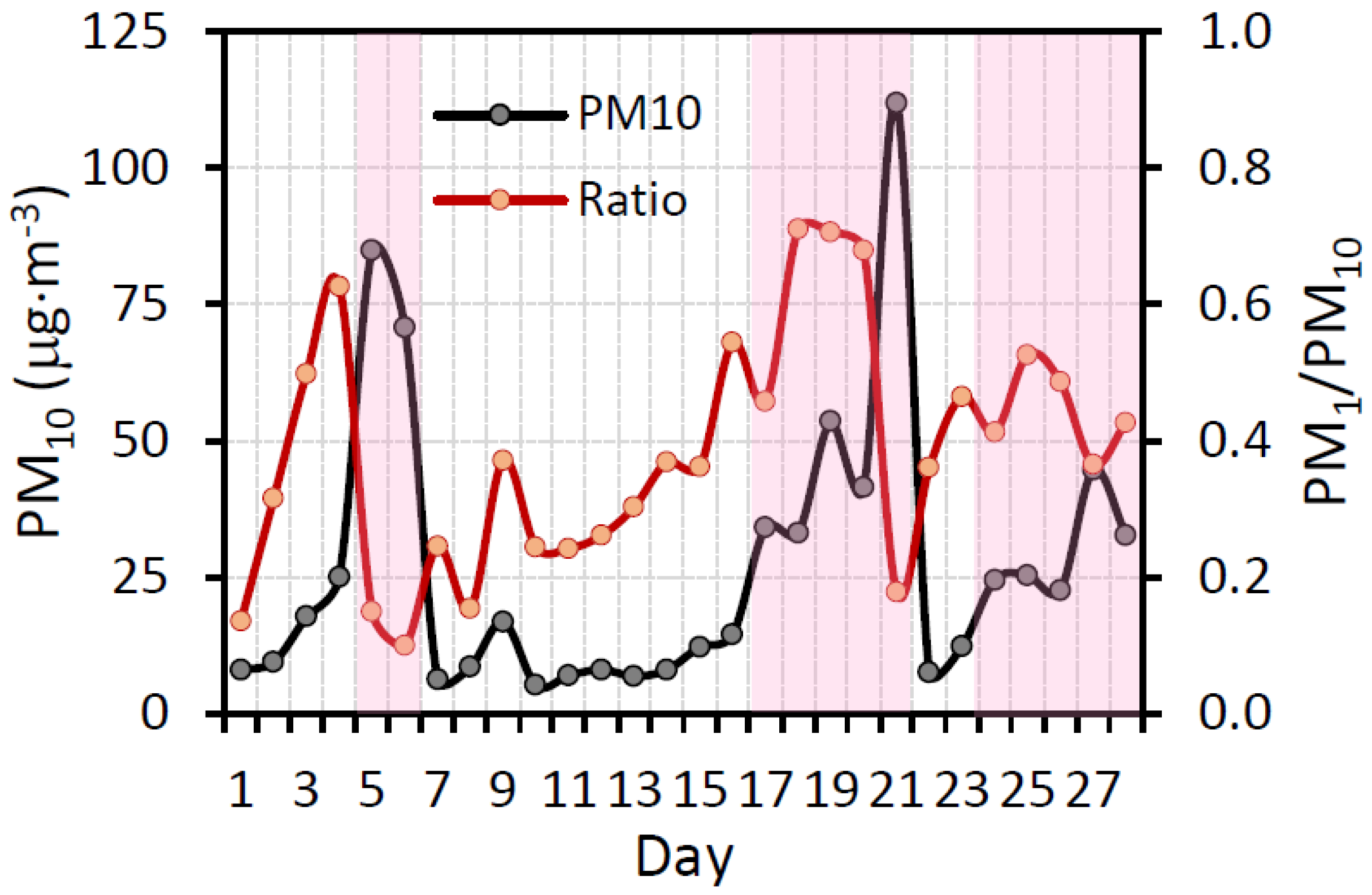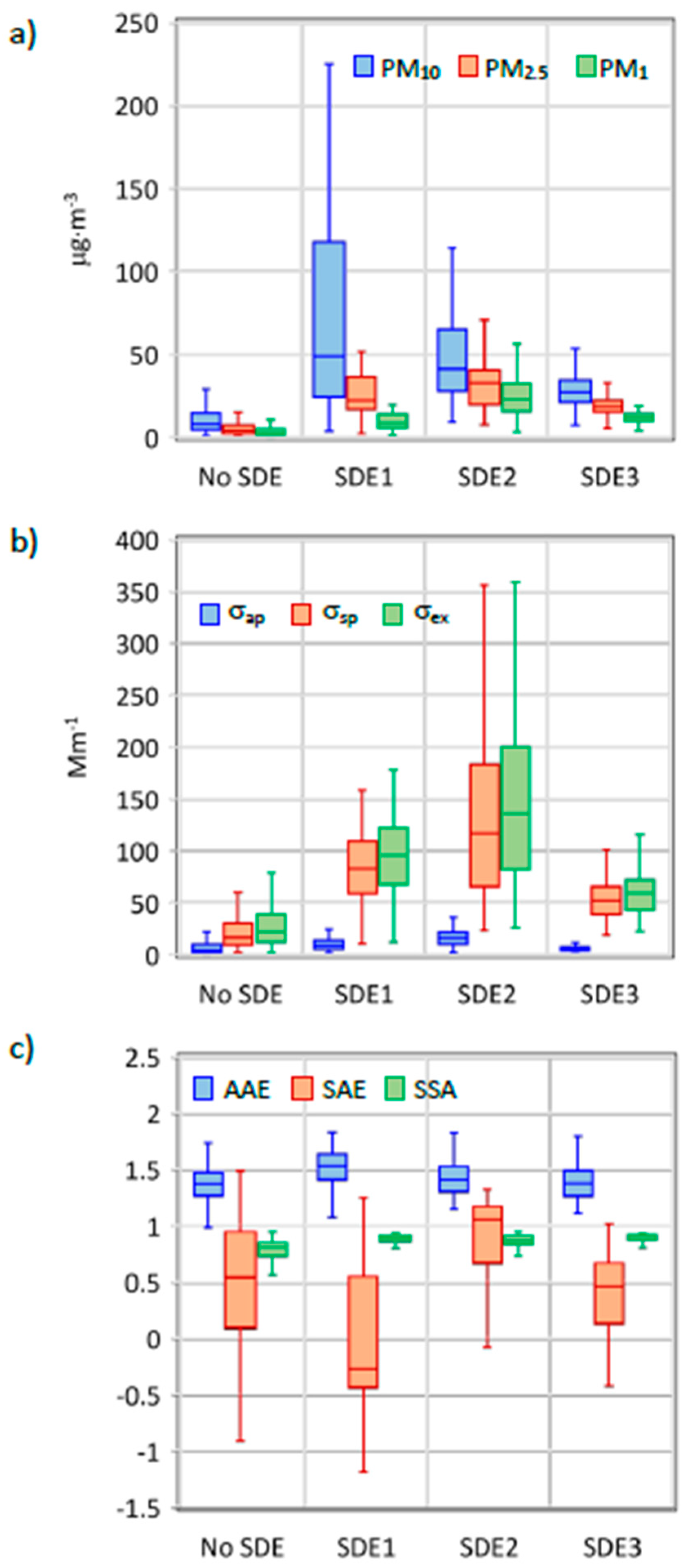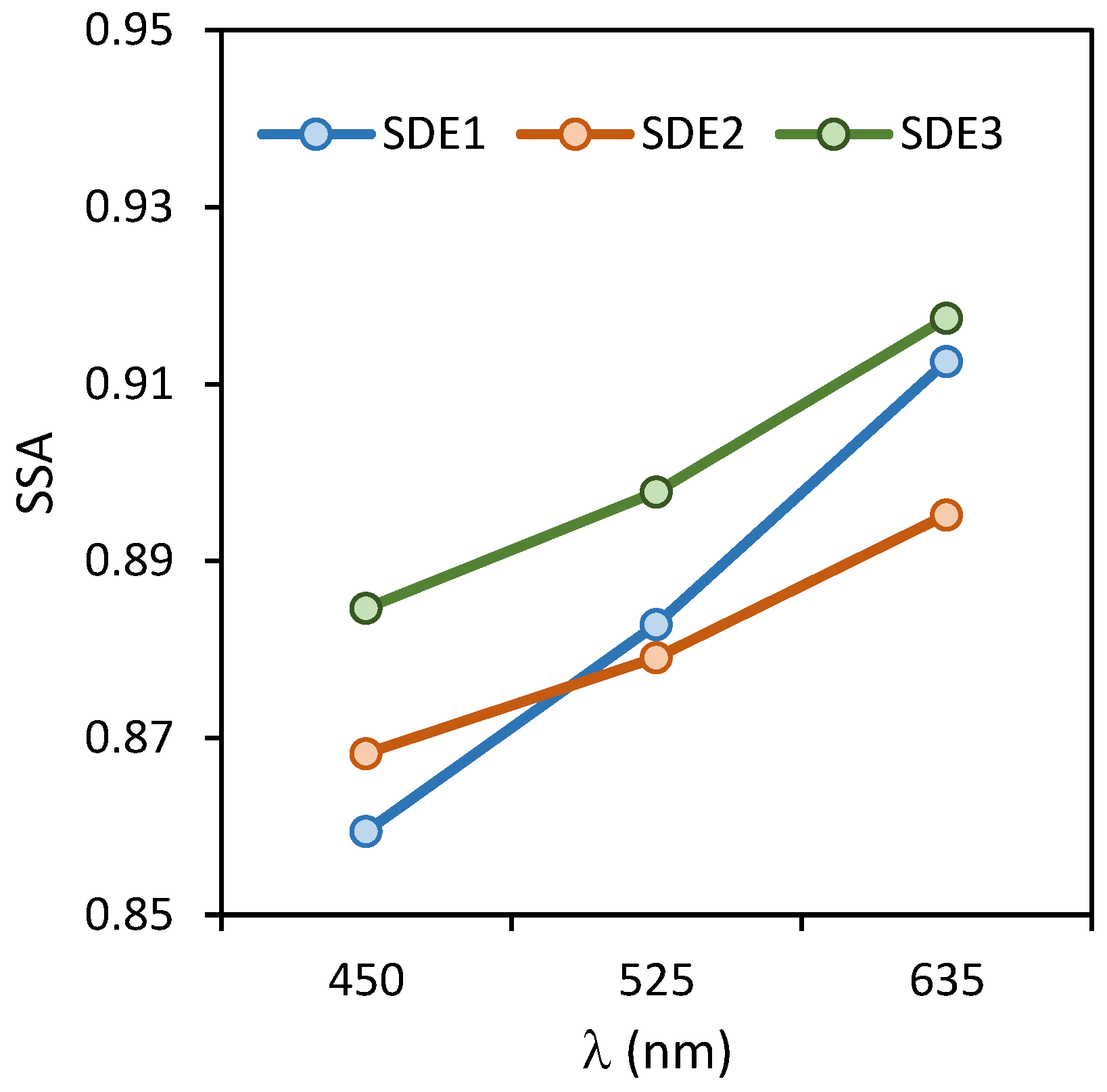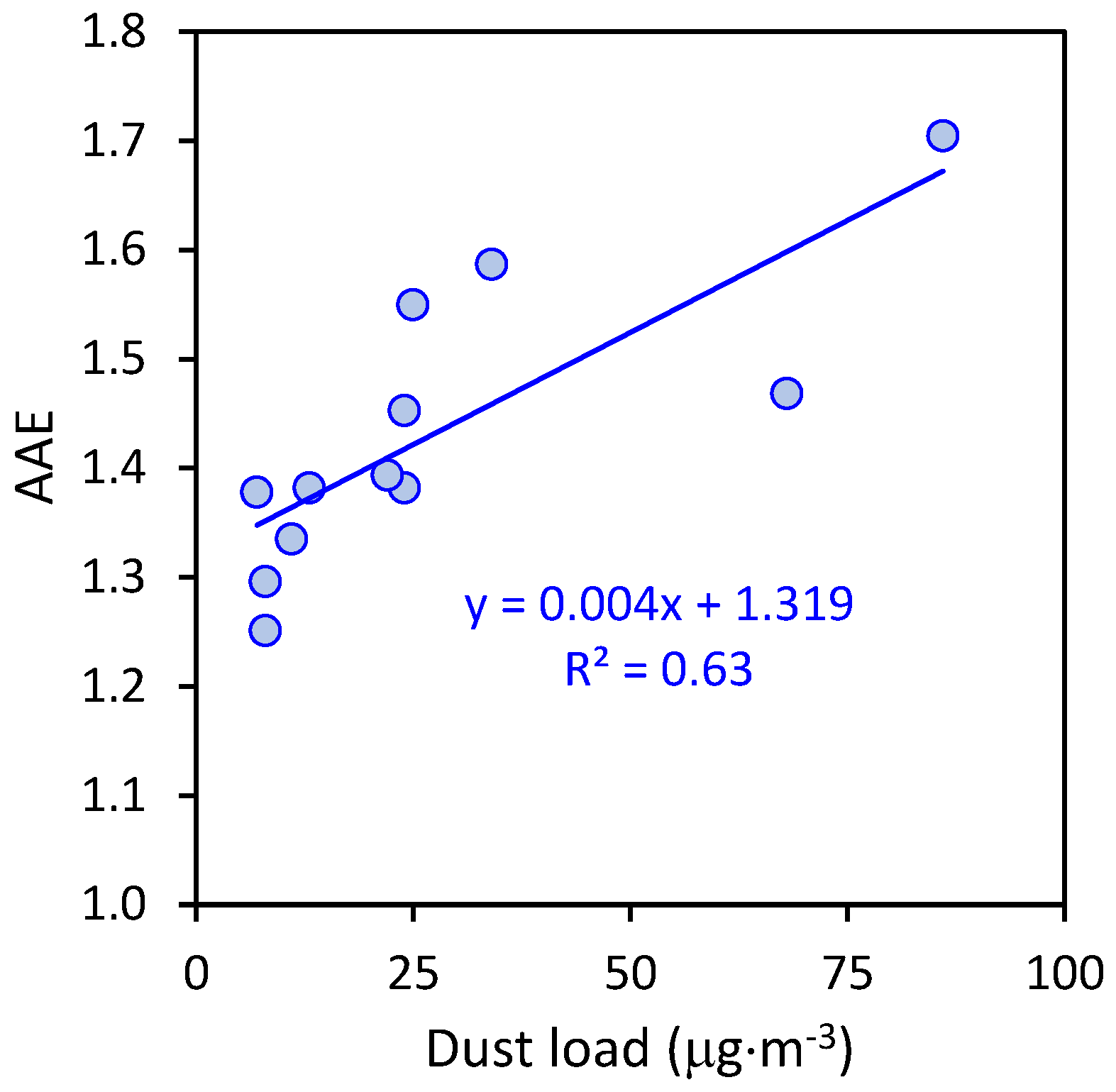The Impact of Intense Winter Saharan Dust Events on PM and Optical Properties at Urban Sites in the Southeast of the Iberian Peninsula
Abstract
:1. Introduction
2. Materials and Methods
2.1. Sampling Sites
2.2. SDE Detection
2.3. Aerosol Optical Properties
3. Results and Discussion
3.1. Impact of Dust Aerosols on PM Concentrations
3.1.1. Influence of SDE on PM10 Levels in Wintertime
3.1.2. Characterization of SDE during February 2021
3.2. Impact of SDE on Optical Properties
3.2.1. General Features
3.2.2. MSE and MAE Values
3.2.3. AOP Variations as a Function of the Characteristics of SDE
4. Conclusions
Supplementary Materials
Author Contributions
Funding
Institutional Review Board Statement
Informed Consent Statement
Data Availability Statement
Acknowledgments
Conflicts of Interest
References
- Pey, J.; Querol, X.; Alastuey, A.; Forastiere, F.; Stafoggia, M. African dust outbreaks over the Mediterranean Basin during 2001–2011: PM10 concentrations, phenomenology and trends, and its relation with synoptic and mesoscale meteorology. Atmos. Chem. Phys. 2013, 13, 1395–1410. [Google Scholar] [CrossRef] [Green Version]
- Barnaba, F.; Bolignano, B.; Di Liberto, L.; Morelli, M.; Lucarelli, F.; Nava, S.; Perrino, C.; Canepari, S.; Basart, S.; Costabile, F.; et al. Desert dust contribution to PM10 loads in Italy: Methods and recommendations addressing the relevant European Commission Guidelines in support to the Air Quality Directive 2008/50. Atmos. Environ. 2017, 161, 288–305. [Google Scholar] [CrossRef]
- Huerta-Viso, A.; Crespo, J.; Galindo, N.; Yubero, E.; Nicolás, J.F. Saharan dust events over the Valencian Community (Eastern Iberian Peninsula): Synoptic circulation patterns and contribution to PM10 Levels. Aerosol Air Qual. Res. 2020, 20, 2519–2528. [Google Scholar] [CrossRef]
- Querol, X.; Pérez, N.; Reche, C.; Ealo, M.; Ripoll, A.; Tur, J.; Pandolfi, M.; Pey, J.; Salvador, P.; Moreno, T.; et al. African dust and air quality over Spain: Is it only dust that matters? Sci. Total Environ. 2019, 686, 737–752. [Google Scholar] [CrossRef]
- Querol, X.; Pey, J.; Pandolfi, M.; Alastuey, A.; Cusack, M.; Pérez, N.; Moreno, T.; Viana, M.; Mihalopoulus, N.; Kallos, G.; et al. African dust contributions to mean ambient PM10 mass-levels across the Mediterranean Basin. Atmos. Environ. 2009, 43, 4266–4277. [Google Scholar] [CrossRef]
- Galindo, G.; Yubero, E.; Clemente, A.; Nicolás, J.F.; Varea, M.; Crespo, J. PM events and changes in the chemical composition of urban aerosols: A case study in the western Mediterranean. Chemosphere 2020, 244, 125520. [Google Scholar] [CrossRef] [PubMed]
- Nicolás, J.F.; Lucarelli, F.; Galindo, N.; Yubero, E.; Crespo, J.; Calzolai, G.; Nava, S. Impact of traffic flows and meteorological events on the hourly elemental composition of fine and coarse particles at an urban site. Aerosol Air Qual. Res. 2020, 20, 991–1001. [Google Scholar] [CrossRef]
- Jiménez, E.; Linares, C.; Martínez, D.; Díaz, J. Role of Saharan dust in the relationship between particulate matter and short-term daily mortality among the elderly in Madrid (Spain). Sci. Total Environ. 2010, 408, 5729–5739. [Google Scholar] [CrossRef]
- Pérez, L.; Tobias, A.; Querol, X.; Künzli, N.; Pey, N.; Alastuey, A.; Viana, M.; Valero, N.; González-Cabré, M.; Sunyer, J. Coarse particles from Saharan dust and daily mortality. Epidemiology 2008, 19, 800–807. [Google Scholar] [CrossRef]
- Tobías, A.; Pérez, L.; Díaz, J.; Linares, C.; Pey, J.; Alastuey, A.; Querol, X. Short-term effects of particulate matter on total mortality during Saharan dust outbreaks: A case-crossover analysis in Madrid (Spain). Sci. Total Environ. 2011, 412–413, 386–389. [Google Scholar] [CrossRef]
- IPCC. Climate Change 2013: The Physical Science Basis. Contribution of Working Group I to the Fifth Assessment Report of the Intergovernmental Panel on Climate Change; Stocker, T.F., Qin, D., Plattner, G.K., Tignor, M., Allen, S.K., Boschung, J., Nauels, A., Xia, Y., Bex, V., Midgley, P.M., Eds.; Cambridge University Press: Cambridge, UK; New York, NY, USA, 2013; p. 1535. [Google Scholar] [CrossRef] [Green Version]
- Pereira, S.N.; Wagner, F.; Silva, A.M. Seven years of measurements of aerosol scattering properties, near the surface, in the southwestern Iberia Peninsula. Atmos. Chem. Phys. 2011, 11, 17–29. [Google Scholar] [CrossRef] [Green Version]
- Valenzuela, A.; Olmo, F.J.; Lyamani, H.; Antón, M.; Titos, G.; Cazorla, A.; Alados-Arboledas, L. Aerosol scattering and absorption Angström exponents as indicators of dust and dust-free days over Granada (Spain). Atmos. Res. 2015, 154, 1–13. [Google Scholar] [CrossRef] [Green Version]
- Ealo, M.; Alastuey, A.; Ripoll, A.; Pérez, N.; Cruz Minguillón, M.; Querol, X.; Pandolfi, M. Detection of Saharan dust and biomass burning events using near-real-time intensive aerosol optical properties in the north-western Mediterranean. Atmos. Chem. Phys. 2016, 16, 12567–12586. [Google Scholar] [CrossRef] [Green Version]
- Fernández, A.J.; Molero, F.; Salvador, P.; Revuelta, A.; Becerril-Valle, M.; Gómez-Moreno, F.J.; Artíñano, B.; Pujadas, M. Aerosol optical, microphysical and radiative forcing properties during variable intensity African dust events in the Iberian Peninsula. Atmos. Res. 2017, 196, 129–141. [Google Scholar] [CrossRef]
- Titos, G.; Ealo, M.; Pandolfi, M.; Pérez, N.; Sola, Y.; Sicard, M.; Comerón, A.; Querol, X.; Alastuey, A. Spatiotemporal evolution of a severe winter dust event in the western Mediterranean: Aerosol optical and physical properties. J. Geophys. Res. 2017, 122, 4052–4069. [Google Scholar] [CrossRef] [Green Version]
- Castañer, R.; Nicolás, J.F.; Crespo, J.; Yubero, E.; Galindo, N.; Caballero, S.; Pastor, C. Influence of air mass origins on optical properties and PM concentrations measured at a high mountain station located in the southwestern Mediterranean. Atmos. Res. 2017, 197, 244–254. [Google Scholar] [CrossRef]
- Formenti, P.; Rajot, J.L.; Desboeufs, K.; Saïd, F.; Grand, N.; Chevaillier, S.; Schmechtig, C. Airborne observations of mineral dust over western Africa in the summer Monsoon season: Spatial and vertical variability of physico-chemical and optical properties. Atmos. Chem. Phys. 2011, 11, 6387–6410. [Google Scholar] [CrossRef] [Green Version]
- Garrett, T.J.; Russell, L.M.; Ramaswamy, V.; Maria, S.F.; Huebert, B.J. Microphysical and radiative evolution of aerosol plumes over the tropical North Atlantic Ocean. J. Geophys. Res. 2003, 108, 4022. [Google Scholar] [CrossRef]
- Denjean, C.; Cassola, F.; Mazzino, A.; Triquet, S.; Chevaillier, S.; Grand, N.; Bourrianne, T.; Momboisse, G.; Sellegri, K.; Schwarzenbock, A.; et al. Size distribution and optical properties of mineral dust aerosols transported in the western Mediterranean. Atmos. Chem. Phys. 2016, 16, 1081–1104. [Google Scholar] [CrossRef] [Green Version]
- Galindo, N.; Yubero, E.; Nicolás, J.F.; Varea, M.; Crespo, J. Characterization of metals in PM1 and PM10 and health risk evaluation at an urban site in the western Mediterranean. Chemosphere 2018, 201, 243–250. [Google Scholar] [CrossRef]
- Galindo, N.; Yubero, E.; Clemente, A.; Nicolás, J.F.; Navarro-Selma, B.; Crespo, J. Insights into de origin and evolution of carbonaceous aerosols in a Mediterranean urban environment. Chemosphere 2019, 235, 636–642. [Google Scholar] [CrossRef] [PubMed]
- Escudero, M.; Querol, X.; Pey, J.; Alastuey, A.; Pérez, N.; Ferreira, F.; Alonso, S.; Rodríguez, S.; Cuevas, E. A methodology for the quantification of the net African dust load in air quality monitoring networks. Atmos. Environ. 2007, 41, 5516–5524. [Google Scholar] [CrossRef]
- Pey, J. Caracterización Físico-Química de Aerosoles Atmosféricos en el Mediterráneo Occidental. Ph.D. Thesis, Departament d’Enginyeria Minera i Recursos Naturals, Universitat Politècnica de Catalunya, Barcelona, Spanish, 2008. Available online: http://hdl.handle.net/10803/6992 (accessed on 3 November 2021).
- Gama, C.; Pio, C.; Monteiro, A.; Russo, M.; Fernandes, A.P.; Borrego, C.; Baldasano, J.M.; Tchepel, O. Comparison of Methodologies for Assessing Desert Dust Contribution to Regional PM10 and PM2.5 Levels: A One-Year Study Over Portugal. Atmosphere 2020, 11, 134. [Google Scholar] [CrossRef] [Green Version]
- Müller, T.; Laborde, M.; Kassel, G.; Wiedensolher, A. Design and performance of a three-wavelength LED-based total scatter and backscatter integrating nephelometer. Atmos. Meas. Tech. 2011, 4, 1291–1303. [Google Scholar] [CrossRef] [Green Version]
- López, J.F.; Cachorro, V.E.; de Frutos, A.M. Analysis of aerosol scattering properties measured by nephelometer at a coastal-rural site in the Atlantic southwest of Iberian Peninsula. J. Atmos. Sol. Terr. Phy. 2015, 132, 48–63. [Google Scholar] [CrossRef]
- Schuster, G.L.; Dubovik, O.; Holben, B.N. Ångström exponent and bimodal aerosol size distributions. J. Geophys. Res. 2006, 111, D07207. [Google Scholar] [CrossRef] [Green Version]
- Collaud Coen, M.; Weingartner, E.; Schaub, D.; Hueglin, C.; Corrigan, C.; Henning, S.; Schwikowski, M.; Baltensperger, U. Saharan dust events at the Jungfraujoch: Detection by wavelength dependence of the single scattering albedo and first climatology analysis. Atmos. Chem. Phys. 2004, 4, 2465–2480. [Google Scholar] [CrossRef] [Green Version]
- Drinovec, L.; Močnik, G.; Zotter, P.; Prévôt, A.S.H.; Ruckstuhl, C.; Coz, E.; Rupakheti, M.; Sciare, J.; Müller, T.; Wiedensohler, A.; et al. The “dual-spot” Aethalometer: An improved measurement of aerosol black carbon with real-time loading compensation. Atmos. Meas. Tech. 2015, 8, 1965–1979. [Google Scholar] [CrossRef] [Green Version]
- Bergstrom, R.W.; Pilewskie, P.; Russell, P.B.; Redemann, J.; Bond, T.C.; Quinn, P.K.; Sierau, B. Spectral absorption properties of atmospheric aerosols. Atmos. Chem. Phys. 2007, 7, 5937–5943. [Google Scholar] [CrossRef] [Green Version]
- Fialho, P.; Hansen, A.D.A.; Honrath, R.E. Absorption coefficients by aerosols in remote áreas: A new approach to decouple dust and black carbón absorption coefficients using seven-wavelength Aethalometer data. J. Aeros. Sci. 2005, 36, 267–282. [Google Scholar] [CrossRef]
- Pateraki, S.; Assimakopoulos, V.D.; Bougiatioti, A.; Kouvarakis, G.; Mihalopoulos, N.; Vasilakos, C. Carbonaceous and ionic compositional patterns of fine particles over an urban Mediterranean area. Sci. Total Environ. 2012, 424, 251–263. [Google Scholar] [CrossRef]
- Squizzato, S.; Masio, M.; Agostini, C.; Visin, F.; Formenton, G.; Harrison, R.M.; Rampazzo, G. Factors, origin and sources affecting PM1 concentrations and composition at an urban background site. Atmos. Res. 2016, 180, 262–273. [Google Scholar] [CrossRef] [Green Version]
- Segura, S.; Estellés, V.; Esteve, A.R.; Marcos, C.R.; Utrillas, M.P.; Martínez-Lozano, J.A. Multiyear in-situ measurements of atmospheric aerosol absorption properties at an urban coastal site in western Mediterranean. Atmos. Environ. 2016, 129, 18–26. [Google Scholar] [CrossRef]
- Titos, G.; Foyo-Moreno, I.; Lyamani, H.; Querol, X.; Alastuey, A.; Alados-Arboledas, L. Optical properties and chemical composition of aerosol particles at an urban location: An estimation of aerosol mass scattering and absorption efficiencies. J. Geophys. Res. 2012, 117, D04206. [Google Scholar] [CrossRef] [Green Version]
- Esteve, A.R.; Estellés, V.; Utrillas, M.P.; Martínez-Lozano, J.A. In-situ integrating nephelometer measurements of the scattering properties of atmospheric aerosols at an urban coastal site in western Mediterranean. Atmos. Environ. 2012, 47, 43–50. [Google Scholar] [CrossRef]
- Schmeisser, L.; Andrews, E.; Ogren, J.A.; Sheridan, P.; Jefferson, A.; Sharma, S.; Kim, J.E.; Sherman, J.P.; Sorribas, M.; Kalapov, I.; et al. Classifying aerosol type using in situ surface spectral aerosol optical properties. Atmos. Chem. Phys. 2017, 17, 12097–12120. [Google Scholar] [CrossRef] [Green Version]
- Cachorro, V.E.; Toledano, C.; Prats, N.; Sorribas, M.; Mogo, S.; Berjón, A.; Torres, B.; Rodrigo, R.; de la Rosa, J.; de Frutos, A.M. The strongest desert dust intrusion mixed with smoke over the Iberian Peninsula registered with Sun photometry. J. Geophys. Res. 2008, 113, D14S04. [Google Scholar] [CrossRef] [Green Version]
- Valenzuela, A.; Olmo, F.J.; Lyamani, H.; Antón, M.; Quirantes, A.; Alados-Arboledas, L. Classification of aerosol radiative properties during African desert dust intrusions over southeastern Spain by sector origins and cluster analysis. J. Geophys. Res. 2012, 117, D06214. [Google Scholar] [CrossRef]
- Gómez-Amo, J.L.; Estellés, V.; Marcos, C.; Segura, S.; Esteve, A.R.; Pedrós, R.; Utrillas, M.P.; Martínez-Lozano, J.A. Impact of dust and smoke mixing on column-integrated aerosol properties from observations during a severe wildfire episode over Valencia (Spain). Sci. Total Environ. 2017, 599–600, 2121–2134. [Google Scholar] [CrossRef]
- Patel, P.N.; Dumka, U.C.; Kaskaoutis, D.G.; Babu, K.N.; Mathur, A.K. Optical and radiative properties of aerosols over Desalpar, a remote site in western India: Source identification, modification processes and aerosol type discrimination. Sci. Total Environ. 2017, 575, 612–627. [Google Scholar] [CrossRef] [Green Version]
- Patel, P.N.; Dumka, U.C.; Babu, K.N.; Mathur, A.K. Aerosol characterization and radiative properties over Kavaratti, a remote island in southern Arabian Sea from the period of observations. Sci. Total Environ. 2017, 599–600, 165–180. [Google Scholar] [CrossRef]
- Dubovik, O.; Holben, B.N.; Eck, T.F.; Smirnov, A.; Kaufman, Y.J.; King, M.D.; Tanre, D.; Slutsker, I. Variability of absorption and optical properties of key aerosol types observed in worldwide locations. J. Atmos. Sci. 2002, 59, 590–608. [Google Scholar] [CrossRef]
- Russell, P.B.; Bergstorm, R.W.; Shinozuka, Y.; Clarke, A.D.; De Carlo, P.F.; Jimenez, J.L.; Livingston, J.M.; Redemann, J.; Dubovik, O.; Strawa, A. Absorption Ångström exponent in AERONET and related data as an indicator of aerosol composition. Atmos. Chem. Phys. 2010, 10, 1155–1169. [Google Scholar] [CrossRef] [Green Version]
- Giles, D.M.; Holben, B.N.; Tripathi, S.N.; Eck, T.F.; Newcomb, W.W.; Slutsker, I.; Dickerson, R.R.; Thompson, A.M.; Mattoo, S.; Wang, S.-H.; et al. Aerosol properties over the Indo-Gangetic plain: A mesoscale perspective from the TIGERZ experiment. J. Geophys. Res. 2011, 116, D15809. [Google Scholar] [CrossRef]






| Station (Type) | Measurements | Time Resolution | Time Period | Purpouse b |
|---|---|---|---|---|
| AGRO (UB) | PM10 | Daily | Feb. (2008–2021) | SDE on PM10 |
| PIN (RB) | PM10 | Daily | Feb. (2008–2021) | SDE on PM10 |
| UMH (UB) | PMx a, AOP | Daily/Hourly | Feb. (2021) | SDE on AOP |
| Dates and Duration (N° days) | PM10/PM2.5/PM1 (µg·m−3) a | PM2.5/PM10 | PM1/PM2.5 | PM1/PM10 | |
|---|---|---|---|---|---|
| SDE1 | 5–6 (2) | 84.8/29.8/12.7 | 0.33 | 0.38 | 0.12 |
| SDE2 | 17–21 (5) | 111.9/49.4/19.9 | 0.71 | 0.74 | 0.55 |
| SDE3 | 24–28 (5) | 44.5/28.4/16.2 | 0.68 | 0.65 | 0.44 |
| σap (λ = 520 nm) | AAE | σsp (λ = 525 nm) | b | SAE | SSA | |
|---|---|---|---|---|---|---|
| Mean | 10.1 | 1.40 | 53.9 | 0.16 | 0.50 | 0.82 |
| Median | 6.3 | 1.39 | 35.5 | 0.15 | 0.57 | 0.84 |
| DS | 10.2 | 0.17 | 55.0 | 0.04 | 0.55 | 0.10 |
| Max | 64.9 | 2.07 | 355.8 | 0.53 | 2.77 | 0.95 |
| Min | 0.3 | 0.98 | 1.8 | 0.10 | −1.19 | 0.36 |
| P5 | 1.3 | 1.15 | 6.9 | 0.12 | −0.46 | 0.62 |
| P95 | 31.3 | 1.69 | 178.6 | 0.22 | 1.22 | 0.93 |
| MSE1 | MSE2.5–1 | MSE10–2.5 | R | MAE1 | MAE2.5–1 | MAE10–2.5 | R |
|---|---|---|---|---|---|---|---|
| 4.44 ± 0.06 | 0.97 ± 0.12 | 0.35 ± 0.04 | 0.96 | 0.61 ± 0.03 | −0.18 ± 0.06 | 0.06 ± 0.02 | 0.60 |
| AAE450–635 | EAE450–635 | |
|---|---|---|
| SDE1 | 1.500 | 0.132 |
| SDE2 | 1.441 | 0.766 |
| SDE3 | 1.429 | 0.446 |
| No SDE | 1.368 | 0.917 |
Publisher’s Note: MDPI stays neutral with regard to jurisdictional claims in published maps and institutional affiliations. |
© 2021 by the authors. Licensee MDPI, Basel, Switzerland. This article is an open access article distributed under the terms and conditions of the Creative Commons Attribution (CC BY) license (https://creativecommons.org/licenses/by/4.0/).
Share and Cite
López-Caravaca, A.; Castañer, R.; Clemente, A.; Yubero, E.; Galindo, N.; Crespo, J.; Nicolás, J.F. The Impact of Intense Winter Saharan Dust Events on PM and Optical Properties at Urban Sites in the Southeast of the Iberian Peninsula. Atmosphere 2021, 12, 1469. https://doi.org/10.3390/atmos12111469
López-Caravaca A, Castañer R, Clemente A, Yubero E, Galindo N, Crespo J, Nicolás JF. The Impact of Intense Winter Saharan Dust Events on PM and Optical Properties at Urban Sites in the Southeast of the Iberian Peninsula. Atmosphere. 2021; 12(11):1469. https://doi.org/10.3390/atmos12111469
Chicago/Turabian StyleLópez-Caravaca, Alba, Ramón Castañer, Alvaro Clemente, Eduardo Yubero, Nuria Galindo, Javier Crespo, and Jose Francisco Nicolás. 2021. "The Impact of Intense Winter Saharan Dust Events on PM and Optical Properties at Urban Sites in the Southeast of the Iberian Peninsula" Atmosphere 12, no. 11: 1469. https://doi.org/10.3390/atmos12111469
APA StyleLópez-Caravaca, A., Castañer, R., Clemente, A., Yubero, E., Galindo, N., Crespo, J., & Nicolás, J. F. (2021). The Impact of Intense Winter Saharan Dust Events on PM and Optical Properties at Urban Sites in the Southeast of the Iberian Peninsula. Atmosphere, 12(11), 1469. https://doi.org/10.3390/atmos12111469






